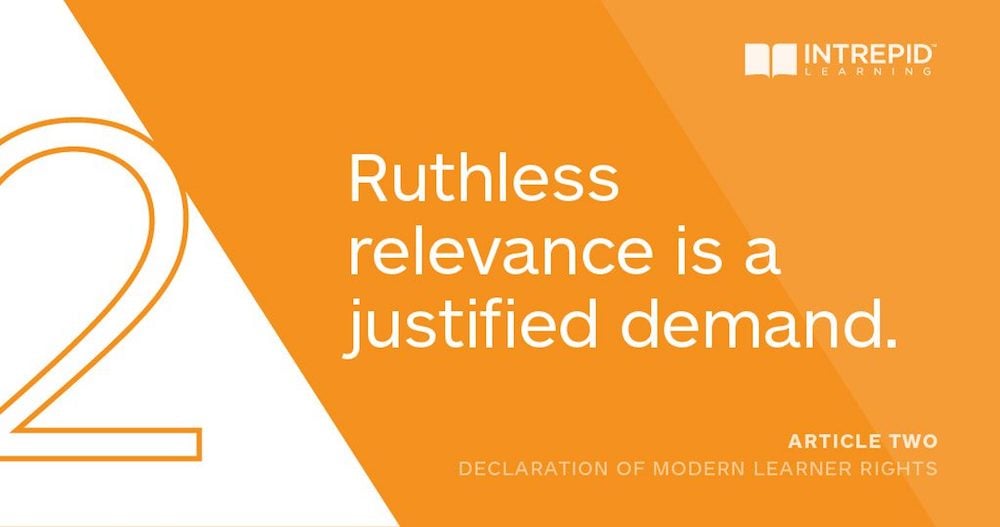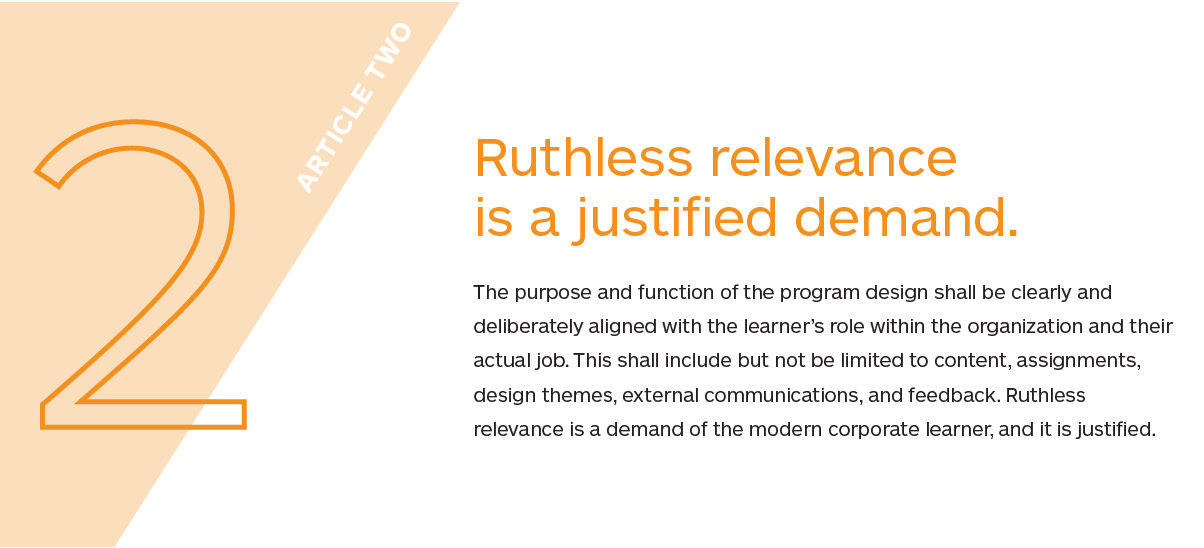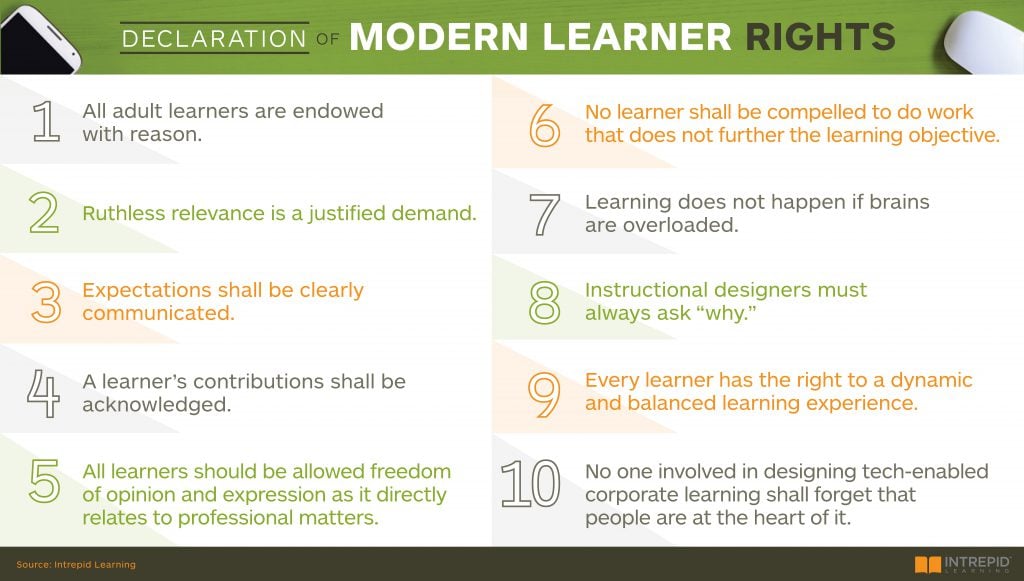
[Note: This is one of a series of blog posts diving deeper into each of the 10 Articles in Intrepid’s Declaration of Modern Learner Rights.]
Ruthless Relevance: the Core of our Job as Learning Experience Designers
In my daydreams about a better corporate world, I overhear workplace comments like these:
I just learned the most useful thing in training! Can we set aside time at the next team meeting for me to share it?
You know that issue we’ve been struggling with? In training yesterday, I think I found a way to handle it.
There’s an easier way to do what you’re doing. If you go to that site we used in training last month, you’ll find templates and examples.
After all, the reason we learning professionals have jobs is to help people improve the way they work—whatever their work may be—so that organizations can thrive.
And if that’s why we’re here, then the learning programs we create need to be immediately, recognizably relevant to any and every employee who encounters them. Cutting corners on relevance doesn’t just take the wind out of your sails; it makes you dead in the water.
Think about the last time you had an interaction with a person or organization in your own life that left you feeling like they didn’t understand you, or what you were asking for. Disappointed? Angry even? For sure like it was a waste of time. You probably felt like leaving and never returning, even though you still didn’t have what you need.

And the whole experience did NOT make you feel curious, reflective, collaborative or productive—emotions we need to trigger in learners.
The flip side to the information overload we all have intimate experience with in our daily lives is people’s appreciation for the range of knowledge available our fingertips. According to a recent Pew Research Center study, that appreciation is increasing, particularly among those ages 18-64 who use multiple devices (smartphone + laptop + desktop + tablet, etc.). In other words, our workforce is becoming more comfortable with their range of knowledge sources even as they struggle with the work/life implications of the amount of content out there.
But the point is, they know they have choices about where and how they can get information, and increasingly they expect to hop around quickly among those options to get what they need.

On some level, training is just one more information source. If our work doesn’t give learners what they need to succeed in their jobs, they will likely leave us for a source that feels more relevant … the same way you wanted to leave that tedious person you met at a conference or on Tinder who kept going on about something you couldn’t relate to.
Given all of that, we in the corporate L&D world only stay relevant to our learners if we exercise “ruthless relevance” in what we create for them.

One Answer to the “Yeah, But How?”
No one sets out to create irrelevant training. It’s difficult to create a learning experience that resonates with a wide range of people. Most of my clients work in global organizations with 10,000-100,000 employees and create training programs meant for large swaths of the company like all managers, all new hires, all sales staff, etc. Offering real relevance to so many individual employees can feel unattainable within budgets and traditional timelines.
One of my early teachers, Ann Marsland, was masterful at sparking thoughtful, concentrated learning in young children. She was also a family friend and once offered me this shopping advice: “The best children’s toy is one that does nothing until the child does something with it.” In other words, require interaction and user input—they’ll thank you for it.
But not just any input; it must be relevant. Young children and corporate employees alike will sniff out gratuitous interaction in a heartbeat, roll their eyes and walk away (mentally, if not physically).

We’ve long known the phrase “use it or lose it,” which (in a more complex form) provides a foundation for Plato’s Socratic method, constructivist learning theory, the education reforms of John Dewey and the case-based approach of Roger Schank, to name a few. So the impact of interaction and user input on learning outcomes isn’t exactly breaking news.
What has been revealed more recently through neuroscience is that asking learners to “use it,” repeatedly and over time, actually alters their brains, which is necessary for retention and mastery. If our brain doesn’t change, we don’t learn well (or not at all). What we communicate to learners needs to resonate with what’s already in their brains (like their everyday job tasks and responsibilities) to capture their attention and get them thinking, applying and doing something with it.
Let’s recap. We know that:
- Until learners feel some kind of connection to the material, their neural networks will not begin firing
- Unless they use the new information or skill, they will not really learn it
- If what we give them doesn’t feel relevant, they’ll abandon it to go looking among other sources
- Our project charters and budgets require us to accomplish all of the above for large, diverse audiences with one program, and that’s a tough challenge
The good news is, you don’t have to create ALL of the ruthless relevance yourself. Obviously you still need to understand the business and learning needs and details about the audience and their work environment to design a good program. But you only need to create some of the ruthless relevance required. If you give learners just enough to help them bridge the gap between new information and their everyday world, they’ll fill in the rest themselves.
So my view is, an instructional designers’ real work is building the right context for learners to create relevant content themselves using activities, projects, discussions and all the other great tools at our fingertips.
Here are some examples of what I’m talking about:
Manager Training Example (Subject: Coaching Skills)
Questions & Projects to Prompt Relevant User-Generated Content
-
What’s the best coaching you’ve ever received? What made it great? What was its impact?
-
Describe a challenging team situation in which one member needed coaching. Did they get it? What was the impact on the rest of the team and resulting work?
-
Identify upcoming work (e.g., busy season, a difficult project, filling a vacancy) that’s likely to create coaching needs. Describe what you can do to prepare.
Sales Training Example (Subject: Customer Analysis)
Questions & Projects to Prompt Relevant User-Generated Content
-
List your available sources of information, explaining what you expect to gain from each source. Next prioritize them, explaining your rationale.
-
Think about a past analysis project (professional or personal) that took too long and didn’t give you the results you needed. In hindsight, what could you have done better?
Change Management Example (Subject: New Process)
Questions & Projects to Prompt Relevant User-Generated Content
-
Review the intended outcomes of the new process. What impact will it have on you and the people you work with most closely? Be specific.
- We’ve created working groups for each part of the process. Join the group associated with the part of the process that piques your interest the most. Work with that group to create a presentation explaining that part of the process to others.
-
Next visit other work groups to see their presentation and ask questions about what’s still confusing to you.
-
Finally, in your original work group, iterate on your original presentation based on the questions and feedback received.
-
In each case, learners are taking advantage of materials provided in training to create new content that is highly relevant to themselves and their colleagues in the training. In fact, they’re creating volumes of content that would have taken you months of effort. But because they are creating it themselves, their understanding and retention is exponentially greater than if you handed it to them, fully vetted and in hi-res.
Our call to action is to hold ourselves accountable to ruthless relevance. I hope this post has gotten your neurons firing about some ways to leverage the modern world of training to make it happen for your learners.
You should also check out the full detailed infographic with explanations for each Article, and keep an eye on the Intrepid blog for more posts about individual Articles by my colleagues in the coming weeks.





